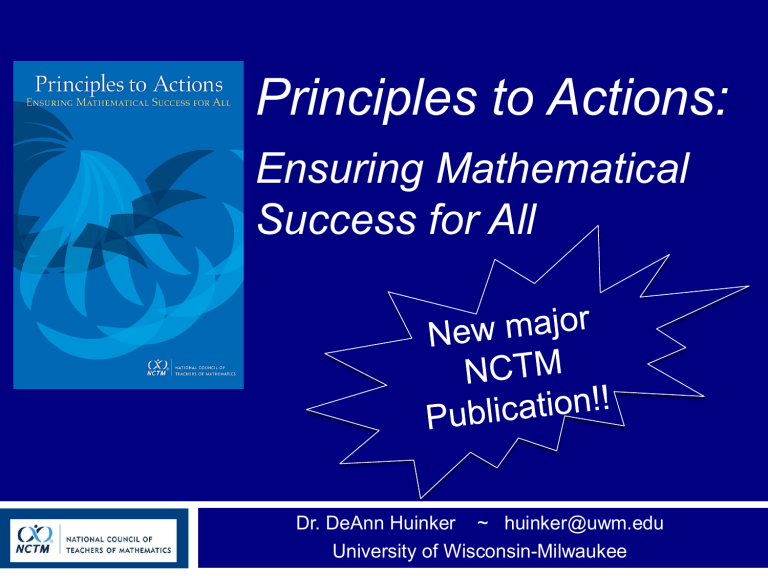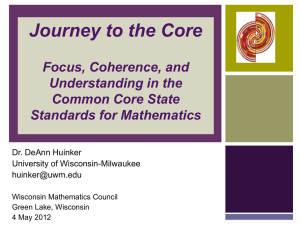ppt - University of Wisconsin–Milwaukee

Principles to Actions:
Ensuring Mathematical
Success for All
Dr. DeAnn Huinker ~ huinker@uwm.edu
University of Wisconsin-Milwaukee
Session Overview
Background and Rationale
Guiding Principles
Effective Mathematics Teaching Practices
Next Professional Steps and Actions
Session Learning Goal
We are learning to:
Consider how we, as leaders, can use Principles to
Actions to support improvement toward excellent mathematics programs and effective teaching and learning of mathematics.
Background
Principles to Actions
What it will take to turn the opportunity of the
Common Core State Standards for Mathematics and other rigorous standards and expectations for student learning into a reality in every classroom, school, and district?
NCTM undertook a major initiative to define and describe the principles and actions, including specific teaching practices, that are essential for a high-quality mathematics education for all students.
Principles to Actions Writing Team
Steven Leinwand American Institutes for Research, D.C.
Daniel J. Brahier Bowling Green State University, Ohio
DeAnn Huinker University of Wisconsin –Milwaukee
Robert Q. Berry III , University of Virginia, Charlottesville, VA
Frederick L. Dillon , Strongsville City Schools, Ohio
Matthew R. Larson Lincoln Public Schools, Nebraska
Miriam A. Leiva University of North Carolina at Charlotte
W. Gary Martin, Auburn University, Auburn, Alabama
Margaret S. Smith, University of Pittsburgh, Pennsylvania
Principles to Actions
Offers guidance to teachers, mathematics coaches, administrators, parents, and policymakers.
Principles to Actions
Identifies 8 research-based, core essential Mathematics
Teaching Practices (MTP).
Describes conditions, structures, policies that support the MTP.
Identifies obstacles, unproductive and productive beliefs, that must be understood, acknowledged, addressed by all stakeholders.
Builds on NCTM’s standards and supports implementation of the Common Core.
Encourages teachers to engage students in mathematical thinking, reasoning, and sense making.
Aims to significantly strengthen teaching and learning in order to attain higher levels of math achievement for all students.
NCTM Website: Principles to Actions
http://www.nctm.org/principlestoactions/
Executive Summary (pdf)
News release
Reflection Guide (pdf)
(Tasks/questions,Connections to other MTP, Applications to practice)
... and more resources coming (e.g., toolkit, slides ...
ebook: $4.99 ($3.99 for NCTM members)
Guiding
Principles
Guiding
Principles for
School
Mathematics
Teaching and Learning
Access and Equity
Curriculum
Tools and Technology
Assessment
Professionalism
Guiding Principles
Turn to the list on the inside front cover.
Read
Turn and talk
Key messages for teachers
Key messages for administrators
Key Messages?
Teaching and
Learning
Principle
Guiding Principle:
Teaching and Learning
An excellent mathematics program requires effective teaching that engages students in meaningful learning through individual and collaborative experiences that promote their ability to make sense of mathematical ideas and reason mathematically.
Obstacles
“It is important to note that these beliefs should not be viewed as good or bad. Instead, beliefs should be understood as unproductive when they hinder the implementation of effective instructional practice or limit student access to important mathematics content and practices .”
(NCTM, 2014, p. 11)
Beliefs about
Teaching and Learning Mathematics
Read the
“Beliefs” table on page 11
Turn and talk
Share your reactions
NCTM’s
Core Set of
Effective
Mathematics
Teaching Practices
Overarching Message
Effective teaching is the non-negotiable core that ensures that all students learn mathematics at high levels.
Effective teaching requires a range of professional structures, supports, and actions at state, district, school, and classroom levels.
“Best Lesson Ever”
Visualize for a moment, the best math lesson you ever taught.
What made it so successful?
What were you the teacher doing?
What were students doing?
What mathematics was being learned?
Establish math goals to focus learning
Elicit & use evidence of student thinking
Implement tasks that promote reasoning & problem solving
Build procedural fluency from conceptual understanding
Mathematics
Teaching
Practices
Support productive struggle in learning mathematics
Use and connect mathematical representations
Facilitate meaningful mathematical discourse
Pose purposeful questions
Student Learning of mathematics . . .
“depends fundamentally on what happens inside the classroom as teachers and learners interact over the curriculum.”
(Ball & Forzani, 2011, p. 17)
Action : To work together as a profession toward implementation of a common set of high-leverage practices that underlie effective teaching ......
“those practices at the heart of the work of teaching that are most likely to affect student learning.”
(Ball & Forzani, 2010, p. 45)
Mathematics Teaching Practices (MTP)
Turn to the MTP list on the inside back cover.
Read, then turn and talk.
Aha!!
Yes!!
Identify a MTP as an area of strength.
Identify a MTP that needs attention.
Establish math goals to focus learning
Elicit & use evidence of student thinking
Implement tasks that promote reasoning & problem solving
Build procedural fluency from conceptual understanding
Mathematics
Teaching
Practices
Support productive struggle in learning mathematics
Use and connect mathematical representations
Facilitate meaningful mathematical discourse
Pose purposeful questions
Mathematics Teaching Practices
Statement of the MTP
Discussion of the research evidence
Classroom illustration
Teacher and student actions
MTP1. Establish math goals to focus learning.
Effective teaching of mathematics establishes clear goals for the mathematics that students are learning, situates goals within learning progressions, and uses the goals to guide instructional decisions.
Pages 12-16:
Skim the discussion and illustration.
Read “Teacher and Student” actions (p. 16); consider the potential of these tables for your work as leaders.
Daro, Mosher, & Corcoran, 2011; Hattie, 2009;
Hiebert, Morris, Berk, & Jensen., 2007; Wiliam, 2011
MTP1. Establish math goals to focus learning.
What are teachers doing? What are students doing?
Establishing clear goals that articulate the mathematics that students are learning as a result of instruction in a lesson, over a series of lessons, or throughout a unit.
Identifying how the goals fit within a mathematics learning progression.
Discussing and referring to the mathematical purpose and goal of a lesson during instruction to ensure that students understand how the current work contributes to their learning.
Using the mathematics goals to guide lesson planning and reflection and to make in-the-moment decisions during instruction.
Engaging in discussions of the mathematical purpose and goals related to their current work in the mathematics classroom (e.g., What are we learning?
Why are we learning it?)
Using the learning goals to stay focused on their progress in improving their understanding of mathematics content and proficiency in using mathematical practices.
Connecting their current work with the mathematics that they studied previously and seeing where the mathematics is going.
Assessing and monitoring their own understanding and progress toward the mathematics learning goals.
Taking
Action
As teacher leaders within your schools and districts, brainstorm ways you might use
Principles to Actions with other teachers and administrators.
Taking Action section, pages 109-117, with specific recommendations for
(1) policymakers and district leaders;
(2) principals, coaches, other school leaders, and (3) teachers.
Session Learning Goal
We are learning to:
Consider how we, as leaders, can use Principles to
Actions to support improvement toward excellent mathematics programs and effective teaching and learning of mathematics.
Thank You!
DeAnn Huinker
University of Wisconsin-Milwaukee huinker@uwm.edu







